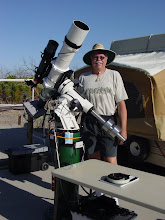The weather finally eased up at Anza this weekend. This time it was almost 20 degrees cooler than last week, being only in the mid-80s but the humidity was still in single digits. There was a chance of thunderstorms and I kept my eye on a line of cumulus building throughout the day 20 miles east of me in the Coachella Valley where Palm Springs is. There was a nice cool outflow blowing from them all day. I started sanding and painting the nine, 18 foot long, 1X1s by about 9 AM and surprisingly completely finished them by 12:30 PM.
I had two curious visitors stop by to see how we're doing, both of them club members out for the weekend. Jim Hannum (whom I met for the first time today) owns the home at the top of the hill with two other club members. Their joint observatory is larger than their house. It houses four large telescopes and they are building another telescope that has a mirror diameter of 36 inches. He offered us some help in that they have a 14 foot open trailer that we can now use anytime to truck stuff to the Anza dump. We are starting to generate a considerable construction debris pile that we will have to truck out in the next few weeks.
Rick Wiggins stopped by a bit later. He has a completely remote controlled observatory on site. I found out he has quite a background in remote control. His current Anza observatory is the third one of his own that he has built. He has also helped Russ Croman and others build some of the remote control telescope businesses in New Mexico, including around Cloudcroft. Just in general conversation today, he has already saved us from making some errors. We were going to control the scopes with Bluetooth from our control desks so we wouldn't need to lay any wire - he said forget Bluetooth - there's too much interference and its too unstable for our purposes. He can show us how to run just one line from each scope to the control desk - that will be for all telescope functions as well as the webcams to observe the equipment. He suggested re-considering the warm room set-ups. Rick said that he is always using white light in his warm room - never red light! If that's the case, John doesn't need a separate warm room in the observing area but can use the main warm room. Rick suggested using what would have been Phil's room as a common bunk room.
John and I will have to consider these things. Fortunately, we have some time for that because the roof comes first. Rick said he would be happy to provide whatever expertise and time we need from him to get our place up and running remotely - wow! He's so generous because he says that he very much likes to help amateurs who are serious about the hobby.
I haven't said much to this point about exactly what I'm going to do with this observatory when its done. I have been interested in astronomy since I was a kid. Other than a short period in the '70s when I did visual observing with a 6 inch reflector, I was basically an arm chair astronomer until '95 when I joined the New Jersey Astronomical Association, of which I am still a long distance member. After moving to Southern California I became interested in astro photography, mainly because I started to wear bifocals and it became very hard for me to look through an eyepiece with my glasses on so I thought that imaging would be a good substitute. By 2004 I was imaging with a DSLR and a small 4 inch refract or on a mount that followed the sky. I frequently came out to this Anza club site for overnight trips on the weekend to do imaging. Its a great spot being far from city lights, at over 4600feet altitude, and very still skies. However, the downside is that the days can be extremely hot in summer, there can be snow in winter, and lots of varmints: scorpions, rattlers, coyotes, and rare mountain lions. Its pretty scary when you are out there alone at night looking at your computer screen and you can hear things moving out beyond your field of vision.
I have also become interested in what is called photometry. That's the measurement of slight changes in the amount of light that an object gives off. Some stars change brightness, asteroid rotation rates can be measured, other stars can explode, yet other stars are multiple and information can be learned by measuring their changing brightness. There is a lot of possibilities for real scientific research with amateur equipment. I'll write more about this anotehr time.
Subscribe to:
Post Comments (Atom)

No comments:
Post a Comment